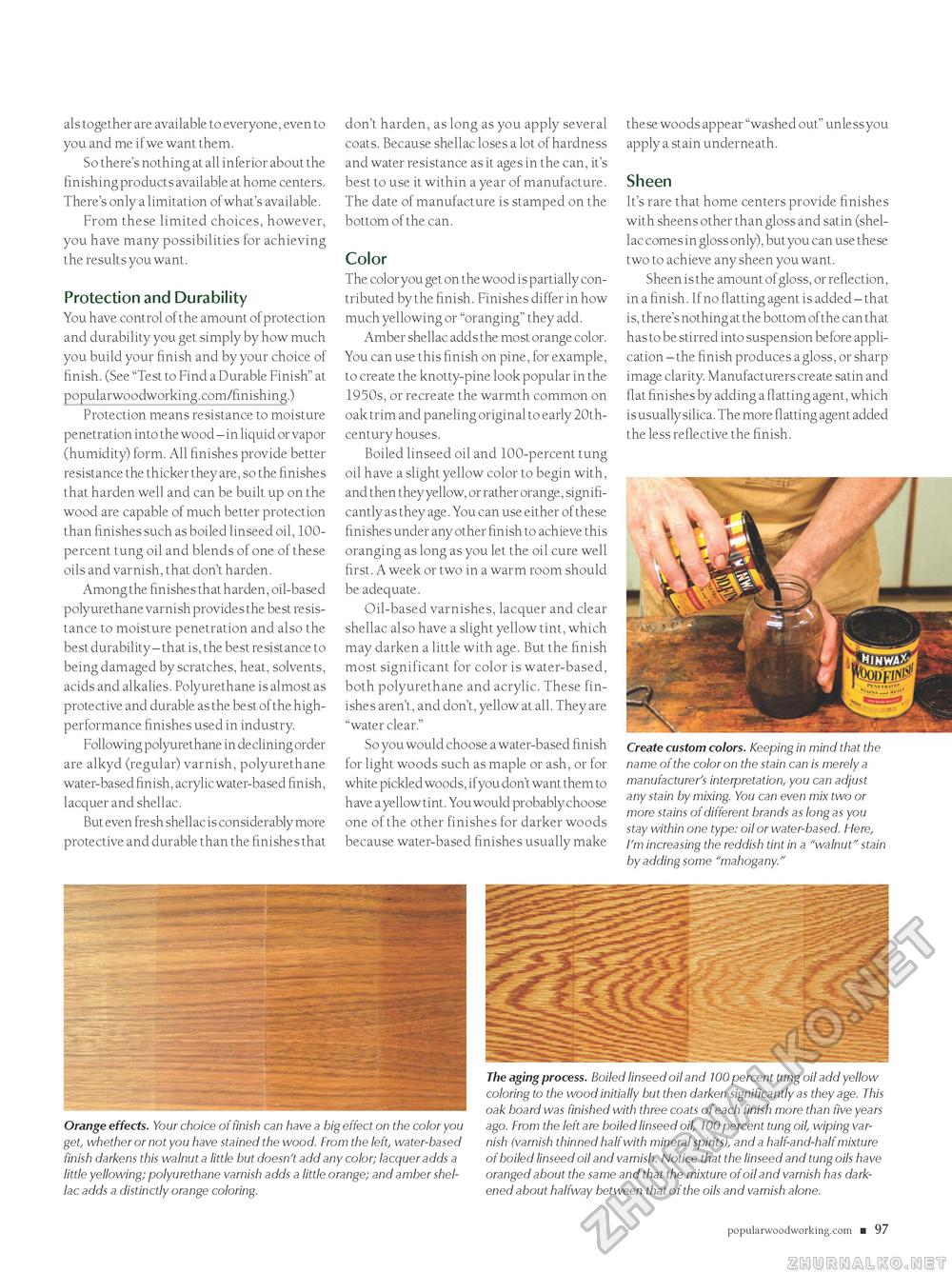Popular Woodworking 2007-11 № 165, страница 99
als together are available to everyone, even to you and me if we want them. So there's nothing at all inferior about the finishing products available at home centers. There's only a limitation of what's available. From these limited choices, however, you have many possibilities for achieving the results you want. Protection and Durability You have control of the amount of protection and durability you get simply by how much you build your finish and by your choice of finish. (See "Test to Find a Durable Finish" at popularwoodworking.com/finishing.) Protection means resistance to moisture penetration into the wood - in liquid or vapor (humidity) form. All finishes provide better resistance the thicker they are, so the finishes that harden well and can be built up on the wood are capable of much better protection than finishes such as boiled linseed oil, 100-percent tung oil and blends of one of these oils and varnish, that don't harden. Among the finishes that harden, oil-based polyurethane varnish provides the best resistance to moisture penetration and also the best durability - that is, the best resistance to being damaged by scratches, heat, solvents, acids and alkalies. Polyurethane is almost as protective and durable as the best of the high-performance finishes used in industry. Following polyurethane in declining order are alkyd (regular) varnish, polyurethane water-based finish, acrylic water-based finish, lacquer and shellac. But even fresh shellac is considerably more protective and durable than the finishes that don't harden, as long as you apply several coats. Because shellac loses a lot of hardness and water resistance as it ages in the can, it's best to use it within a year of manufacture. The date of manufacture is stamped on the bottom of the can. Color The color you get on the wood is partially contributed by the finish. Finishes differ in how much yellowing or "oranging" they add. Amber shellac adds the most orange color. You can use this finish on pine, for example, to create the knotty-pine look popular in the 1950s, or recreate the warmth common on oak trim and paneling original to early 20th-century houses. Boiled linseed oil and 100-percent tung oil have a slight yellow color to begin with, and then they yellow, or rather orange, significantly as they age. You can use either of these finishes under any other finish to achieve this oranging as long as you let the oil cure well first. A week or two in a warm room should be adequate. Oil-based varnishes, lacquer and clear shellac also have a slight yellow tint, which may darken a little with age. But the finish most significant for color is water-based, both polyurethane and acrylic. These finishes aren't, and don't, yellow at all. They are "water clear." So you would choose a water-based finish for light woods such as maple or ash, or for white pickled woods, if you don't want them to have a yellow tint. You would probably choose one of the other finishes for darker woods because water-based finishes usually make these woods appear "washed out" unless you apply a stain underneath. Sheen It's rare that home centers provide finishes with sheens other than gloss and satin (shellac comes in gloss only), but you can use these two to achieve any sheen you want. Sheen is the amount of gloss, or reflection, in a finish. If no flatting agent is added - that is, there's nothing at the bottom of the can that has to be stirred into suspension before application - the finish produces a gloss, or sharp image clarity. Manufacturers create satin and flat finishes by adding a flatting agent, which is usually silica. The more flatting agent added the less reflective the finish. Create custom colors. Keeping in mind that the name of the color on the stain can is merely a manufacturer's interpretation, you can adjust any stain by mixing. You can even mix two or more stains of different brands as long as you stay within one type: oil or water-based. Here, I'm increasing the reddish tint in a "walnut" stain by adding some "mahogany." Orange effects. Your choice of finish can have a big effect on the color you get, whether or not you have stained the wood. From the left, water-based finish darkens this walnut a little but doesn't add any color; lacquer adds a little yellowing; polyurethane varnish adds a little orange; and amber shellac adds a distinctly orange coloring. The aging process. Boiled linseed oil and 100 percent tung oil add yellow coloring to the wood initially but then darken significantly as they age. This oak board was finished with three coats of each finish more than five years ago. From the left are boiled linseed oil, 100 percent tung oil, wiping varnish (varnish thinned half with mineral spirits), and a half-and-half mixture of boiled linseed oil and varnish. Notice that the linseed and tung oils have oranged about the same and that the mixture of oil and varnish has darkened about halfway between that of the oils and varnish alone. popularwoodworking.com ■ 97 |








